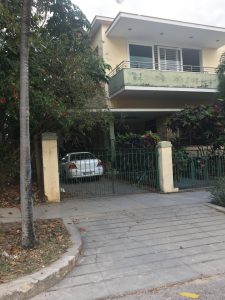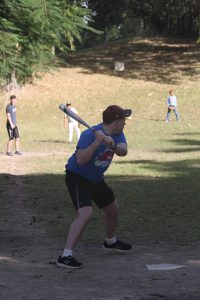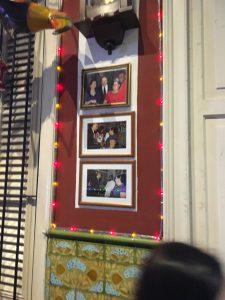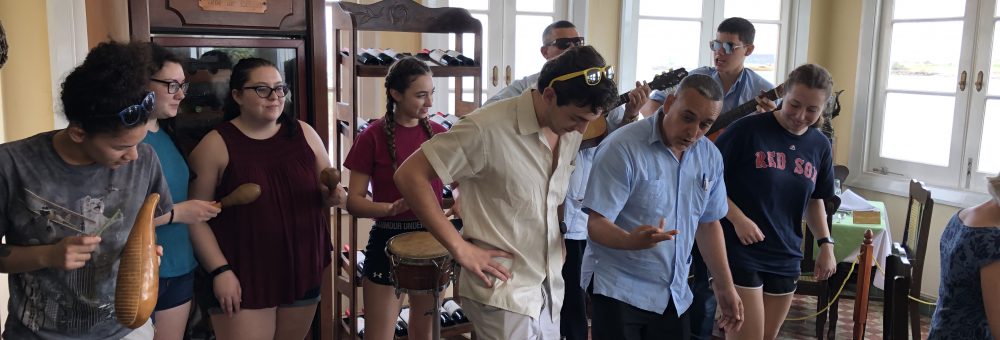Today was a day full of history and life. Our day started in Old Havana. Early in the morning, our reliable and personable bus driver, Arturo, dropped us off at the mouth of Old Havana, which also happens to be next to the mouth of the Port of Havana. From there, you could see countless remnants of the Spanish colonial empire that used to exist there. Across the waterway, we could see a colossal stone fortress that seemed to extend for hundreds of yards. In the Plaza de Armas, we were surrounded by a church, an old castle, the former palace in which the Spanish colonial governors would live, and a lovely garden in the square.
As we got closer to these only monuments, the footprint the Spanish had left behind became more and more apparent. Not only were these buildings European in their architecture, but the artwork they held was of Spanish conquistadors and Christian missionaries; things that were not native to Cuba before the Spanish arrived. I was impressed with the degree of preservation the Cubans were able to achieve with the buildings. Some of the buildings were hundreds of years old, but it was very apparent that the Cuban government took a lot interest in assuring that the buildings stay around for people to see and appreciate.
As we began to walk through the rest of Old Havana, we immediately sensed that we were walking through a time machine. As hinted by the name, Old Havana had a lot of old buildings. Many were in disrepair, and a lucky few looked like they likely did when they were built. One of those buildings was a hotel in which Ernest Hemingway spent countless nights in Havana before finally settling down in a house not far from the city. Five stories tall, with a rooftop bar, an old-fashioned elevator, and a lovely open floor plan, the building was painted bright pink and was a popular tourist attraction. A quick side note: Cubans really like Ernest Hemingway. There are countless paintings and monuments to him throughout Havana.
Continuing to walk through Old Havana, it became clear to us that the economic situation in Cuba is not up to standards with what we Americans were used to. One cannot walk 50 feet without seeing a tiny derelict shop selling the same exact stuff as the shop next to it. The shop keepers are constantly calling out to try to attract business. The restaurants were similar; there would be salespeople sent out sometimes over 100 meters from their restaurant to try to pull tourists in from busy streets. There were countless beggars and stray animals. There are many people struggling to make ends meet in Cuba, which made it hard as a tourist because there was an expectation that I always had money to give.
After a long stroll through Old Havana, we then took another long stroll through the neighborhood that surrounded our residence, known as Vedado. Vedado can be thought of as the Cambridge of Havana. It is almost at the heart of the city, but it is a quiet pocket of residential neighborhoods which, as with the rest of Havana, varied from literal piles of rubble to beautiful Spanish colonial homes. Must like Cambridge, Vedado is somewhat of a cultural hub with a lot of underground bars and music scenes. For example, Arturo dropped us off in a park with a statue of John Lennon, which is conveniently next to a night club known as the Yellow Submarine.
Between Old Havana and Vedado, we took a short stop in a giant place known as Revolution Square. It is a huge open area surrounded by government buildings, and, at its center, is a 109m tall tower with a statue of Jose Marti, Cuba’s revolutionary founding father. On the walls of the surrounding buildings are the faces of Che Guevara and Fidel Castro. I was impressed with the scale of the place; it truly was vast. I was also struck by how Cubans were so proud of their revolution. I appreciated the strong sense of national identity that Cuba felt despite the challenges they faced as a small Caribbean country that was bullied by the United States. To conclude, seeing the evolution of the Revolution from the early days of Spanish colonial era to resisting the United States was fun to witness in one day. Cuba maintains an eclectic cultural balance embracing and displaying their past while also demonstrating a strong will to pave an independent path for themselves.
Appreciating The Smaller Things
I woke up early, tired from the long day of travel that started when I left my house at 8:00 am the day before and ended around 12 hours later when we finally reached the residencia. We awoke to our first day in Cuba at 8:30 to a delicious breakfast of pancake like saucers with a fruity syrup that was complemented by the bounty of fresh fruit and freshly made bread that adorned the table.

We followed breakfast by collecting the items we required for the day. For the first day, this included a variety of baseball gear that we brought to donate to Cuban kids who play little league baseball. After a short bus ride, we reached a small dirt clearing with patches of grass where there were Cuban children practicing baseball with their coach. As one of the island’s heroes, Hemingway donated more than just the cultural significance of his writing and his estate to the Cuban people; he also created a little league for the Cuban kids in Havana and gave the league some of his land to play on.
I was struck by the impact that our simple gifts of a few pieces of equipment, some baseballs, and baseball cards had on the kids. The enjoyment that they derived from practicing baseball with each other and playing against us was touching. I remember when I was their age, that all the kids would want the best equipment, and towards the end of my own baseball career, some of my teammates would spend hundreds of dollars on bats. Meanwhile, the Cuban kids seemed to be grateful that they had any equipment, and they played with gloves that would have been thrown out long ago in my town’s little league. The grace with which the players managed to navigate the field and their ability to predict the movement of the ball on such a non-level surface was impressive, especially given that two of our group tripped on the uneven ground and fell while trying to field balls. Watching the joy spread across each child’s face as they hit or fielded a ball numbered among the best experiences, I had the entire trip.

After playing baseball with the kids in Hemingway’s still operational little league, we were given the opportunity to tour his house. We had the unique opportunity to look in on Hemingway’s daily life for the 20-year period that he lived in Cuba. His house was extremely well preserved, and still contains all the original books that were in his personal library as well as the notes that he took on his height and weight on his bathroom wall. His numerous trophies from safaris in Africa were a testament to his outdoorsmanship as well as his nature as a world traveler. Also on display at Hemingway’s house were various works of art with him as the subject, and his famous boat, the Pilar. Hemingway loved Cuba, hence it being his home for longer than any other place that he stayed. Hemingway’s time in Cuba ended up being longer than any of his four marriages (his longest marriage was to Mary Welsh for 15 years, and he lived in Cuba for twenty-plus years). Ernest Hemingway may well have been the single person who most closely represented the essence of Cuba, even more so than many of the nation’s founding leaders. Hemingway enjoyed traveling and bringing different parts of different countries back from his travels. He also incorporated all his experiences and all that he learned in his many travels into much of his writing. Cuba’s essence as a mashup of Caribbean, native, south American, north American, European, and African cultures, in addition to a small Chinese influence is close to the mashup of experiences that influenced Hemingway’s life and writing.

Our walking tour of the Vedado neighborhood where our residencia was located was unfortunately delayed until the next day due to concerns about the weather. One of the experiences we got to have instead was wandering around the neighborhood in our group and having the opportunity to have authentic interactions with the Cuban people. We were able to buy some souvenirs during this time, and one of the experiences I had while souvenir shopping will stick with me for the rest of my life. I tipped a couple 5 CUC, which is about equivalent to 6 USD for wood burning some writing into a pair of wooden cars that I bought as gifts. To me, the 5 CUC was almost nothing; that’s about how much I make in about 25 minutes of work, but to the couple that I bought the cars from, it seemed like it was a Godsend. They jumped up and down with joy and continuously thanked me for my generosity. I thought nothing of it at first, but then when I thought about it more, I realized that what I gave them was equivalent to almost one quarter of their government mandated monthly salary of around 20 CUC. When I did the math out, I was amazed to realize that the money was worth about 120 times more to them than it did to me. To me, that was a mind-numbing statistic that made me realize the extreme poverty of Cuba, even more than what I saw of the infrastructure there and more than what I saw of the condition of the people and their lives as I walked in the streets.
The event that wrapped up the day was the welcome dinner at one of the restaurants that Obama dined at during his 2016 trip to Cuba. It was a very nice experience that brought us all closer together for the rest of the trip and gave us the opportunity to sit down with everyone and debrief after our first day in Cuba. It was also eye-opening to see how much Obama’s visit and his attempt to normalize relations with Cuba was appreciated by the Cuban people. There were so many pictures of him and the owner around the restaurant that it had the appearance of being an Obama-themed restaurant. It touched me to know how much the Cuban people are willing to look past the differences between our country’s governments to reach out to us and other Americans as people rather than members of an opposing nation.
Welcome!
This traveling seminar will use the Cuban experience as a backdrop for experiential learning, along with discussions with professionals in that particular field of study, and writing assignments designed to allow students to reflect upon their experience studying and living in Cuba. Students will gain a multi-disciplinary overview of Cuban contemporary culture and further understanding from a cultural, socio-political and historical context.
Please feel free to read the blogs from previous trips to Cuba listed below or from other destinations across the globe UMass Lowell students travel to.
- 2019: Havana Cuba: Global Correspondent
- 2018: Traveling Seminar: Cuba – Perceptions & Realities
- 2017: Havana, Cuba: Cultural Immersion
- 2016: Havana, Cuba: Cultural Immersion
